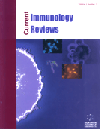- Home
- A-Z Publications
- Current Immunology Reviews (Discontinued)
- Previous Issues
- Volume 9, Issue 4, 2013
Current Immunology Reviews (Discontinued) - Volume 9, Issue 4, 2013
Volume 9, Issue 4, 2013
-
-
Structural and Pathogenic Mechanisms Centered on Muscle-Specific Tyrosine Kinase in Autoimmune Neuromuscular Junction Disorders
More LessMyasthenia gravis (MG), an autoimmune neuromuscular junction disorder characterized by fatigable weakness of voluntary muscles including ocular, facial, oropharyngeal, limb and respiratory muscles with a prevalence of about 150-200 per million, is a disease of the postsynaptic neuromuscular junction where acetylcholine receptors (AChRs) are targeted by autoantibodies in 80-85% of MG patients. We face unres Read More
-
-
-
Type 2 Innate Lymphoid Cells in Allergic Disease
More LessAuthors: Sean Lund, Hannah H. Walford and Taylor A. DohertyType II innate lymphoid cells (ILC2) are a novel population of lineage-negative cells that produce high levels of Th2 cytokines IL-5 and IL-13. ILC2 are found in human respiratory and gastrointestinal tissue as well as in skin. Studies from mouse models of asthma and atopic dermatitis suggest a role for ILC2 in promoting allergic inflammation. The epithelial cytokines IL-25, IL-33, and TSLP, as well as the lipid mediator leukotriene Read More
-
-
-
The Neutrophil: An Underappreciated But Key Player in SLE Pathogenesis
More LessAuthors: Neelakshi R. Jog, Roberto Caricchio and Philip L. CohenSystemic lupus erythematosus (SLE) is a complex multi-organ autoimmune disease, the pathogenesis of which is still not deciphered. The neutrophil, an innate immune cell critical in controlling infections, has traditionally not been regarded as a contributor to systemic autoimmunity due to its lack of specificity and short lifespan. Many recent findings have instead shown that these cells have a role in regulating the ad Read More
-
-
-
Hemophagocytic Lymphohistiocytosis (HLH): An Update
More LessAuthors: Manisha Madkaikar, Snehal Mhatre, Kanjaksha Ghosh and Sudhir GuptaHemophagocytic lymphohistiocytosis (HLH) is a rare life-threatening disease of immune regulation, clinically characterized by prolonged fever, cytopenias and hepatosplenomegaly. Low or absent natural killer (NK) cell and CD8+ cytotoxic T lymphocyte (CTL) cytotoxicity is one of the hallmarks of HLH. This results in ineffective infection control leading to prolonged and excessive activation of antigen presenting cells (m Read More
-
-
-
The Brain-Immune-Gut Triangle: Innate Immunity in Psychiatric and Neurological Disorders
More LessAuthors: Attila Szabo and Eva RajnavolgyiThe communication between the immune and central nervous systems has been known for decades. Although the biological rules and complexity of the neuroimmune axis is yet to be clarified, in the modern era of immunology and clinical neurosciences it has become a dynamically evolving paradigm. In this review we trace the major findings of this emerging field with a special focus on innate immune cells and their phyloge Read More
-
-
-
Atopy and Role of Mast Cells in IgE-Mediated Allergic Diseases
More LessAtopy is characterized by a high production of IgE in response to common allergens exposure and by positive responses to skin-prick test against specific antigens. Atopy can contribute to the development of atopic asthma and atopic eczema. This condition involves the participation of different cells including mast cells that express the high-affinity Fc receptor for IgE, the FcεRI receptor. Crosslinking of FcεRI-bound IgE i Read More
-
-
-
Towards a Poly-Functional Synthetic-Antimalarial Vaccine: Incorporating Non-Natural Elements into Artificially-Made Peptides for Mimicking Functional Pathogen Ligand Structures Representing New Site-Directed Vaccine Components
More LessAuthors: Jose Manuel Lozano and Manuel Elkin PatarroyoThe molecular basis for obtaining novel anti-malarial vaccine candidates depends on a considered selection of antigenic peptides, mainly derived from Plasmodium antigens’ non-polymorphic regions. Since such targeted-molecules are poorly immunogenic when tested as vaccine components, they usually have to be modified to overcome their immunological phenotype. Transition state theory, explaining how peptidases catalys Read More
-
Volumes & issues
Most Read This Month
Article
content/journals/cir
Journal
10
5
false
en


